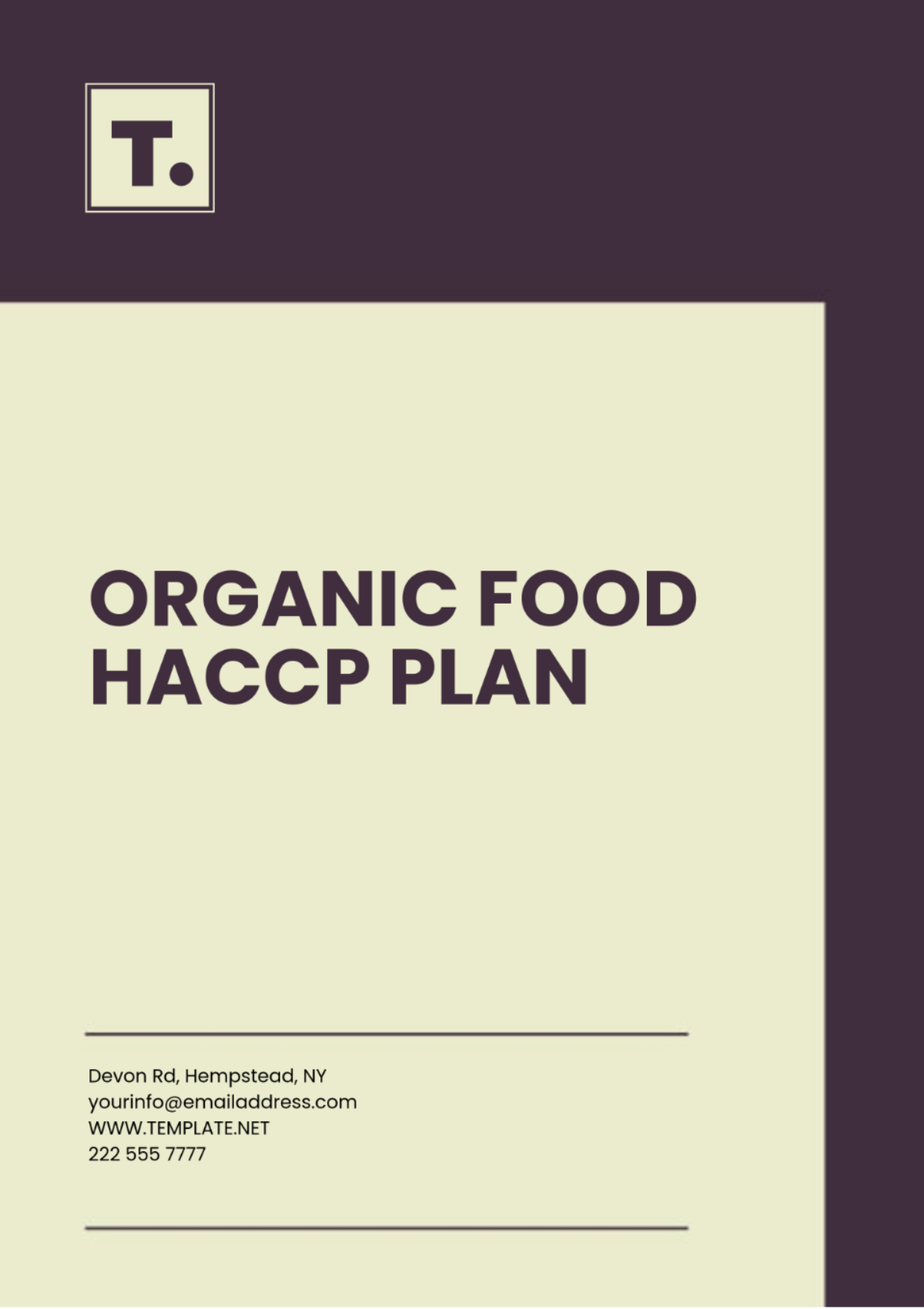FDA-Compliant HACCP Plan
Date: April 28, 2060
Prepared by: [YOUR NAME]
I. Introduction
This FDA-compliant HACCP (Hazard Analysis Critical Control Point) plan is established to uphold the highest standards of food safety by providing a structured framework for identifying, evaluating, and controlling hazards throughout the food production process. The scope of this plan encompasses all critical aspects of production, from the receipt of raw materials to the distribution of the final products. This systematic approach aims to minimize food safety risks and ensure compliance with FDA regulations, thereby safeguarding consumer health and maintaining the integrity of our organic snack products.
II. HACCP Team
A committed team of trained professionals with specific roles and responsibilities enables the effective implementation and continuous upkeep of the HACCP plan.
Carter White - HACCP Coordinator: Leads the HACCP team, ensuring effective communication, training, and compliance with the HACCP plan. Manages overall plan implementation and continuous improvement.
Noah Lucas - Quality Assurance Manager: Oversees quality control processes to ensure compliance with regulatory standards. Conducts assessments and implements necessary adjustments.
Layla Young - Production Supervisor: Manages daily production operations, ensuring adherence to food safety protocols and staff training. Monitors production flow and addresses operational challenges.
Caleb Robinson - Food Safety Specialist: Conducts hazard analyses and risk assessments, providing expertise in food safety regulations. Leads training on hazard identification and control measures.
Levi Johnson - Maintenance Engineer: Maintains production equipment to prevent contamination risks. Oversees sanitation protocols and ensures machinery operates efficiently.
III. Product Description
Our product line features a diverse selection of organic snacks, including granola bars, nut mixes, and fruit snacks. Each item is crafted using high-quality, all-natural ingredients, specifically designed to cater to health-conscious consumers seeking nutritious and convenient snack options.
A. Product Ingredients
Whole Grains: Oats, quinoa
Nuts and Seeds: Almonds, sunflower seeds
Dried Fruits: Raisins, cranberries
Natural Sweeteners: Honey, agave syrup
B. Intended Use
These products are aimed at health-oriented consumers of all ages seeking nutritious snacks. They are suitable for various dietary preferences, including vegetarian and gluten-free options, ensuring broad market appeal
IV. Process Flow Diagram
Below is a detailed visual representation of our production process, illustrating each step involved from raw material receipt to final product distribution:
Ingredient Receiving: The process includes a meticulous examination and complete validation of the raw materials to ensure they comply with the necessary quality and safety standards.
Mixing: Combining ingredients according to established recipes while maintaining strict hygiene standards.
Forming and Cutting: The process involves carefully shaping the product into uniform sizes, which is essential for maintaining consistent quality throughout all of the items produced.
Baking/Drying: Cooking or dehydrating to achieve the desired texture while eliminating potential microbial hazards.
Cooling: The process requires precise temperature control during cooling to avoid moisture accumulation, preserving the product's original quality and structural integrity.
Packaging: Sealing products using food-safe materials to ensure freshness and safety during transportation.
Storage and Distribution: Storing products under optimal conditions to maintain quality before delivery to retailers and consumers.
V. Hazard Analysis
The following table identifies potential hazards associated with each process step, along with corresponding control measures to mitigate risks:
Process Step | Potential Hazards | Control Measures |
|---|---|---|
Ingredient Receiving | Contamination (biological, chemical, physical) | Supplier verification, visual inspections, and sampling/testing protocols to assess ingredient safety. |
Mixing | Cross-contamination | Strict sanitation of equipment and tools, along with allergen management practices. |
Baking/ Drying | Microbial growth due to inadequate cooking times | Implement time and temperature control with calibrated thermometers and continuous monitoring. |
Cooling | Moisture accumulation leads to spoilage | Regular monitoring of ambient temperatures and humidity levels in cooling areas. |
Packaging | Contamination during packaging | Utilize sanitized materials and enforce good handling practices throughout the packaging process. |
VI. Critical Control Points (CCPs)
The following Critical Control Points (CCPs) have been identified where control measures are essential to prevent or eliminate hazards:
Ingredient Receiving: Ensure all incoming materials are verified and meet safety standards through inspection and documentation.
Baking/Drying: Monitor and maintain strict adherence to required cooking times and temperatures to ensure product safety.
Packaging: Confirm that packaging processes effectively prevent contamination, including using safe, hygienic materials and practices.
VII. Monitoring Procedures
To ensure that CCPs remain within established limits, the following monitoring methods will be employed:
Regular Temperature Checks: Implement both automated systems and manual spot checks to monitor temperatures at critical points throughout the process.
Visual Inspections: Conduct routine checks for contamination, adherence to sanitation protocols, and proper handling of materials and products.
Batch Testing for Microbial Contamination: Periodically sample and test finished products for microbial safety to verify compliance with safety standards.
VIII. Corrective Actions
If monitoring indicates a deviation from established limits, the following corrective actions will be implemented:
Halt Production: Immediately stop production activities to prevent the release of unsafe products into the market.
Identify Root Causes of Deviation: Conduct a thorough investigation to determine the source of the problem and document findings
Retrain Staff on Correct Procedures: Provide targeted retraining to affected staff to reinforce proper practices and prevent future occurrences.
Dispose of Affected Product: Safely remove and document the disposal of any products that do not meet safety standards, ensuring proper record-keeping.
IX. Verification Procedures
To confirm the effectiveness of the HACCP plan, the following verification activities will be conducted:
Internal Audits: Schedule regular audits to evaluate compliance with HACCP protocols and identify areas for improvement.
Regular Review of Monitoring Records: Continuously assess monitoring data and records to ensure adherence to established safety standards.
Validation of Control Measures: Periodically test and validate the effectiveness of implemented control measures at CCPs to ensure they are functioning as intended.
X. Record Keeping
Comprehensive documentation is crucial for tracking compliance and corrective actions. The following records will be maintained:
CCP Monitoring Records: Detailed logs documenting all monitoring activities for each critical control point.
Corrective Action Logs: Records of all corrective actions taken in response to deviations, including investigations and resolutions.
Verification Activity Reports: Documentation of all verification activities, including audit results, findings, and actions taken to address issues.





























